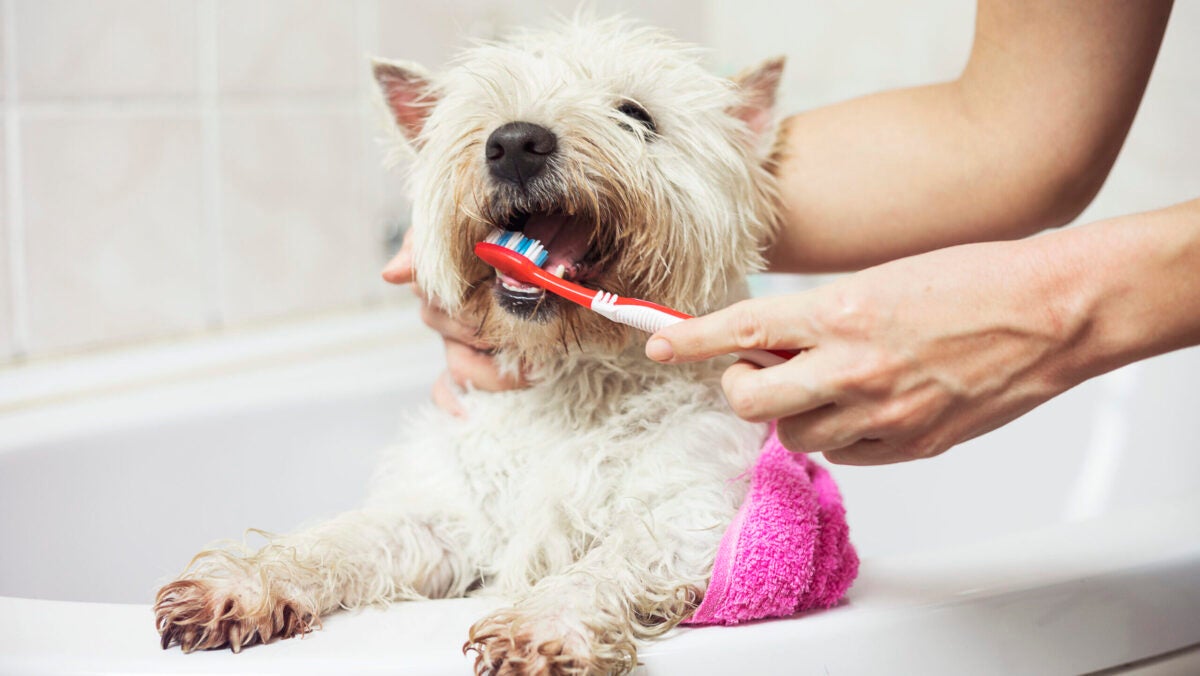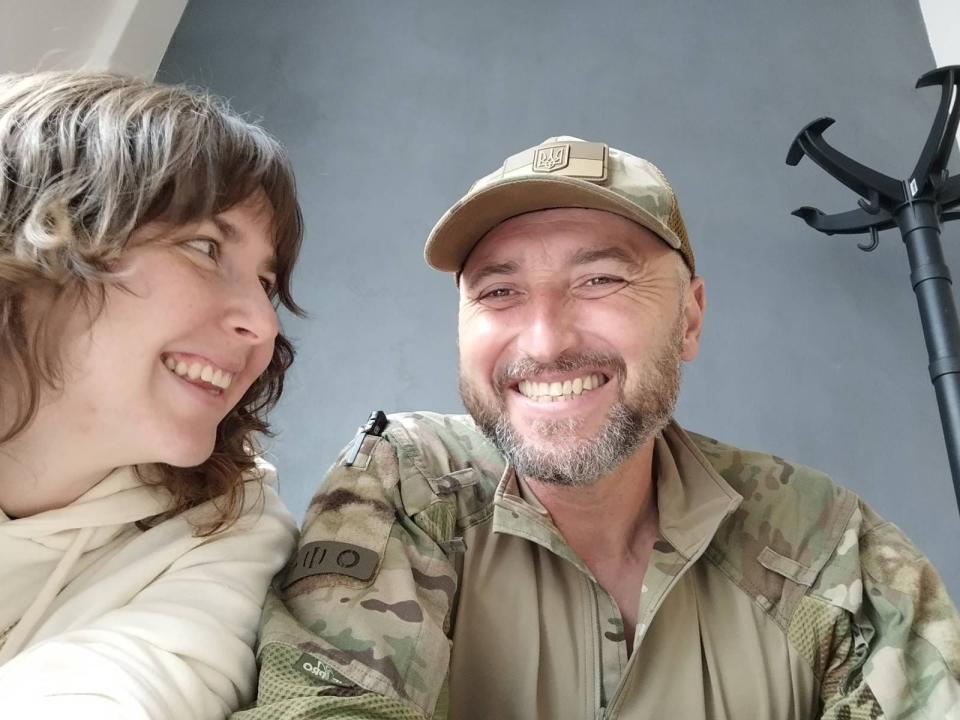
Key points
- The cost of dog teeth cleaning is between $170 and $350, while an ultrasonic cleaning with other procedures under anesthesia can cost up to $4,000.
- Brushing your dog’s teeth regularly and using safe treats, toys, food and water additives can prevent health problems, keep vet costs down and improve your dog’s lifespan.
- Symptoms your dog may have from teeth issues include bad breath, a loss of appetite, pawing its face, irritability and apparent pain while chewing.
How much does dog teeth cleaning cost?
Dog dental cleaning costs can be anywhere from $170 to $350 if done by a general practitioner veterinarian.
If your dog requires more thorough dental cleaning and examination under general anesthesia, the cost can be between $500 and $4,000, especially if a board-certified veterinary dentist treats them. Depending on your dog’s age, overall health and the dental problems they’re experiencing, a veterinary dentist with specialized training may be worth the cost.
“For dogs with anesthesia risks, such as those with heart disease or kidney disease, more intensive anesthetic monitoring and aftercare can increase the cost,” said Dr. Jacqueline Brister, DVM and medical writer.
“If tooth extractions, in which diseased teeth are removed, and treatment of diseased or infected gums are needed, the price can increase significantly as well, depending on how many teeth are extracted, how difficult the extractions are and the degree of damage to the underlying bone and surrounding gums and dental structures,” Brister said.
Factors that affect the cost of dog teeth cleaning
Multiple factors determine the cost of cleaning your dog’s teeth, including:
- Pre- and post-cleaning requirements. Your dog may need bloodwork, dental X-rays and an oral examination prior to the cleaning. Depending on what occurs during the cleaning, your dog may also need antibiotics or pain meds after the dental procedure.
- The veterinarian you use. A board-certified veterinary dentist will charge more to clean your dog’s teeth than a general practitioner veterinarian.
- What happens during the dental cleaning: Your dog may require ultrasonic cleaning below the gum line, a root canal or extraction, which will cost more than a routine dental cleaning to remove tartar buildup.
- Your dog’s health and age: Older dogs or those with health problems may require extra monitoring or testing during and after the procedure.
What is included in dog teeth cleaning costs?
It’s a good idea to get an itemized estimate before the cleaning procedure to see what is included in the price, as it can vary by veterinary clinic. The vet usually includes an oral exam, anesthesia, scaling, polishing and dental X-rays in the cost of cleaning a dog’s teeth.
But what some veterinarians include in a package, another may consider an optional cost, like X-rays. Whether they are included or cost extra, X-rays are still part of the standard of care, as they can show if your dog has:
- An infection.
- Bone loss.
- Cysts.
- Dead teeth.
- Oral cancer.
What is not included in dog teeth cleaning costs?
Anything not included in the initial cost estimate is typically not included in the cost of teeth cleaning for your dog. This can include additional treatments for periodontal disease, necessary extractions and root canals.
Does pet insurance cover teeth cleaning for my dog?
Pet insurance may cover your dog’s teeth cleaning, but it depends on the policy.
- Most pet insurance plans cover dental only if your pet is injured or has a medical issue, like a cracked tooth.
- Some pet insurance wellness plan add-ons cover dental cleanings, but they may not cover the total cost.
Is the cost of pet insurance worth it? What pet insurance covers
Other ways to pay for dog dental cleaning
If you don’t pay the full cost of dog teeth cleaning up front, some vet offices have in-house payment plan options that allow you to split the bill into monthly payments. But if that’s not an option, ask if they take CareCredit. CareCredit works like a credit card but only for veterinary and human health expenses.
The nice thing about CareCredit is if you charge at least $200, you can receive up to 24 months of no-interest payments. However, if you don’t pay off the full balance within the promotional period, you’ll be charged interest on the total amount back to the original purchase date. The standard APR is 29.99%, but it differs based on your credit score.
Another option to consider is crowdfunding through Waggle or another site. Donors may pay a small fee when they donate, so make sure you check first and factor those into the amount of funds you ask for.
Symptoms of teeth issues in dogs
Bad breath is one of the most common symptoms of teeth issues in dogs.
“While it’s normal for dogs and cats to not have fresh breath, an unusually foul odor can be a sign of dental problems,” said Dr. Erin Tate, DVM and VP of Clinical Development for CityVet. But that’s not the only symptom to look for in your furry friend that can be a sign they’re experiencing dental discomfort.
Dr. Tate recommends you look for these signs your dog may need to see the vet for a dental exam:
- Bleeding gums.
- Chewing on one side of the dog’s mouth.
- Difficulty eating or loss of appetite.
- Excessive drooling.
- Loose or missing teeth.
- Nasal discharge or sneezing.
- Red, swollen or receding gums.
- Swelling under the eyes that can indicate a tooth abscess or infection.
- Visible tartar.
Your dog may also exhibit behavior changes, like being more irritable and less active.
Is teeth cleaning required for dogs?
The American Animal Hospital Association (AAHA) recommends a veterinarian check your dog’s teeth and gums every six months for any signs of oral issues that may need to be addressed.
Although teeth cleaning is not required for dogs, veterinarians strongly recommend your dog receive regular professional teeth cleanings for their overall health.
“In many cases, regular dental cleanings are recommended as a preventative measure to avoid serious dental diseases, which can lead to more significant health issues if left untreated. Dental disease can cause pain, lead to tooth loss, and can affect other organs in the body, including the heart and kidneys, if bacteria from the mouth enter the bloodstream.”
Dr. Erin Tate, DVM and CityVet VP of Clinical Development
How often should dogs have their teeth cleaned?
If your dog is not experiencing any symptoms, its age, breed and size will determine when it should get its first dental cleaning. The AAHA recommends small- and medium-sized dogs receive a cleaning at 1 or 2 years old, while large dogs should be scheduled between 2- and 3 years old.
Small dogs, especially brachycephalic breeds like French bulldogs and pugs, should receive an annual cleaning, as they’re more prone to dental diseases and gingivitis. Large dogs can get a cleaning every other year, with annual checkups.
“Dogs that are prone to periodontal disease need a checkup every six months. People go for a dental cleaning and checkup every six months, and dogs and cats need to go for the same reason.”
Jacqueline Brister, DVM
How to prevent dog dental issues
The best way to prevent dog dental issues is to have a regular routine at home focusing on your dog’s oral health. Regularly brushing your dog’s teeth, for example, can help prevent dental problems.
Avoid hard chews, like antlers, bones and hard nylon toys. Instead, choose dental chews and toys appropriate for your dog’s size and chewing habits that are designed to prevent tartar buildup and reduce plaque.
You can also give your dog dental treats or put additives water that can freshen its breath and reduce plaque. Check for treats, additives and toys approved by the Veterinary Oral Health Council (VOHC). “If a product is approved by the VOHC, it means that with regular use, it can help prevent periodontal disease,” said Dr. Brister.
Some VOHC-approved products include:
- Canine Greenies.
- HealthyMouth Water Additive for Dogs.
- Improved Milk-Bone Brushing Chews for Dogs.
- OraVet Dental Hygiene Chews for Dogs.
- Petsmile Professional Pet Toothpaste.
- ProDen PlaqueOff Powder.
- Tartar Shield Soft Rawhide Chews for Dogs.
- TropiClean Fresh Breath Dental Health Solution.
Teeth cleaning for dogs FAQs
Unlike humans, dogs must be sedated or put under anesthesia to have their teeth cleaned. This makes the cost of getting their teeth cleaned more expensive. If they need bloodwork, X-rays or other dental work done, like an extraction, the cost of dental care will increase. You can keep your dog’s dental cleaning costs low by taking preventive measures, like brushing its teeth at home and giving it VOHC-approved food, toys and treats.
If you want your dog to continue to live a healthy life, it is usually worth the cost of getting its teeth cleaned. “Age is not a disease, so caring for an older dog’s teeth is just as important as caring for a younger dog’s, often with minimal impact on anesthesia concerns,” said Dr. Brister. “If deemed healthy enough for anesthesia by a veterinarian, elderly dogs will have a much better quality of life if they continue to have regular cleanings and any periodontal disease managed appropriately.”
Dr. Tate said to “focus on the outside surfaces of the teeth, where plaque tends to accumulate. Gently brush in a circular motion, paying special attention to the gum line.” Look for an American Dental Association (ADA) compliant toothbrush to clean your dog’s teeth. “Effective toothbrushes tend to have thin, bushy bristles, which are ideal for brushing teeth above and below the gum line,” said Dr. Brister. You can also use tooth wipes, like the VOHC-approved HealthyMouth Anti-Plaque Wipes for Dogs.
There are multiple benefits of cleaning your dog’s teeth. It can help you detect oral health problems sooner, prevent other health issues, like kidney or heart disease, and prevent foul breath, pain, discomfort, tooth loss and periodontal disease. Regular brushing is a great way to decrease future veterinary costs and increase your dog’s chances of living a long, healthy life.



